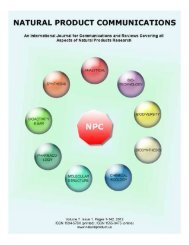This Issue is Dedicated to the Memory of Professor Ivano Morelli
This Issue is Dedicated to the Memory of Professor Ivano Morelli
This Issue is Dedicated to the Memory of Professor Ivano Morelli
Create successful ePaper yourself
Turn your PDF publications into a flip-book with our unique Google optimized e-Paper software.
1104 Natural Product Communications Vol. 1 (12) 2006 Simões-Pires et al.<br />
in ppm as δ rel. <strong>to</strong> Me 4 Si (int. std.). LC/MS was<br />
performed directly after UV-DAD measurements. A<br />
Finningan LCQ ion trap (Finningan MAT, San Jose,<br />
CA, USA) with APCI interface was used with <strong>the</strong><br />
following conditions: capillary temp. 150°C;<br />
vaporizer temp. 370°C; positive mode; sheath gas<br />
flow: 60 arb, corona needle current 5 µA; spectra<br />
(150-900 mu). HRESIMS was performed using a<br />
Bruker FTMS 4.7T. TLC: silica gel 60 F 254 Al sheets<br />
(Merck), detection at 254 nm and with vanillinsulfuric<br />
acid reagent. LC/UV-DAD analys<strong>is</strong> <strong>of</strong> <strong>the</strong><br />
alkaloid extract was performed on a Hewlett-Packard<br />
(Waldbronn, Germany) Series 1100 pho<strong>to</strong>diode array<br />
detec<strong>to</strong>r (DAD) liquid chroma<strong>to</strong>graph system. The<br />
separation was achieved on a Nucleosil 100-5 C 18 AB<br />
column (125 x 4.6 mm i.d., 5 µm; Macherey-Nagel)<br />
with MeOH/H 2 O (containing Et 3 N 2 mM) in <strong>the</strong><br />
gradient mode (10% <strong>of</strong> MeOH <strong>to</strong> 100% in 40 min).<br />
The flow rate was 1 mL/min; <strong>the</strong> UV traces were<br />
measured at 210 and 254 nm and UV spectra (DAD)<br />
were recorded between 200 and 500 nm. HPLC<br />
micr<strong>of</strong>ractionation: Fractions were collected, after <strong>the</strong><br />
LC/UV analys<strong>is</strong>, every 1 min (1 mL) in Eppendorf<br />
tubes by a Gilson collec<strong>to</strong>r (FC204). After collection,<br />
all fractions were evaporated <strong>to</strong> dryness on a<br />
Speedvac system (RCT 90, Jouan). The content <strong>of</strong><br />
each fraction was suspended in 1 mL <strong>of</strong> PMN<br />
suspension and <strong>the</strong>n used for <strong>the</strong> antichemotactic<br />
assay. Semi-preparative HPLC was carried out with<br />
a Shimadzu LC-8A pump equipped with a Knauer<br />
UV detec<strong>to</strong>r using a Symmetry-Prep column (7 µm,<br />
19x150 mm, Waters).<br />
Plant material: P. myriantha was collected in<br />
Reserva Estadual do Turvo, Derrubadas Rio Grande<br />
do Sul, Brazil and identified by M. Sobral. A voucher<br />
specimen (M. Sobral et al., 8913) was deposited in<br />
<strong>the</strong> ICN Herbarium (Universidade Federal do Rio<br />
Grande do Sul, Por<strong>to</strong> Alegre, Rio Grande do Sul,<br />
Brazil).<br />
Extraction and <strong>is</strong>olation: Dried leaves (823 g) were<br />
extracted with EtOH (3.5 l) at room temperature. The<br />
extract was concentrated under vacuum at 40 °C and<br />
an alkaloid extract was obtained by classical<br />
acid/base extraction. In addition <strong>to</strong> <strong>the</strong> alkaloid rich<br />
CH 2 Cl 2 extract, it was noticed that <strong>the</strong> aqueous<br />
fraction was also positive for alkaloids with<br />
Dragendorff reagent. In order <strong>to</strong> extract <strong>the</strong>se<br />
alkaloids, a second partition was conducted between<br />
<strong>the</strong> residual aqueous fraction and n-BuOH. The<br />
butanolic extract (1 g) was purified by semipreparative<br />
HPLC using Symmetry-Prep column<br />
(7 µm, 19 x 150 mm, Waters), MeOH-H 2 O (30:70)<br />
with Et 3 N 2 mM, flow rate 10 mL/min, UV 254 nm)<br />
providing alkaloids 1 (33 mg) and 2 (12 mg).<br />
Acid hydrolys<strong>is</strong>: Compounds 1 and 2 were submitted<br />
<strong>to</strong> hydrolys<strong>is</strong> with 20 mL <strong>of</strong> HCl 0.05 N at 65°C<br />
during 24h. Sugars were extracted by partition with<br />
n-BuOH and were compared by TLC (solvent:<br />
AcOEt/Formic acid/H 2 O 100:20:30; detected with<br />
p-an<strong>is</strong>aldehyde-H 2 SO 4 reagent) with reference<br />
compounds: glucose (R f 0.40), arabinose (R f 0.45),<br />
fruc<strong>to</strong>se (R f 0.41), rhamnose (R f 0.64), and galac<strong>to</strong>se<br />
(R f 0.33), all 1 mg/mL in H 2 O. Compounds 1 and 2<br />
gave glucose (R f 0.40).<br />
Enzymatic hydrolys<strong>is</strong>: Compounds 1 and 2 were<br />
treated with β-D-glucosidase in 1 mL NaOAc buffer<br />
(pH 5.0) for three days at 40°C. The aglycones were<br />
extracted by partition with n-BuOH, and submitted <strong>to</strong><br />
LC/UV-DAD analys<strong>is</strong> hydrolys<strong>is</strong> in order <strong>to</strong> confirm<br />
hydrolys<strong>is</strong>.<br />
Antichemotactic assay: Chemotax<strong>is</strong> was measured in<br />
a Boyden chamber by <strong>the</strong> method previously<br />
described [24]. Prior <strong>to</strong> <strong>the</strong> chemotactic assay, rat<br />
leukocytes were treated with 100 μg/mL <strong>of</strong> each<br />
sample (alkaloids and extract), at 37°C for 1 h.<br />
Plasma collected from rats was incubated at 37°C for<br />
30 min with 65 μg/mL <strong>of</strong> lipopolysaccharide (LPS)<br />
from Escherichia coli, and <strong>the</strong>n diluted in Hanks<br />
buffer 1:5 (v/v). Chemotactic migration <strong>of</strong> leukocytes<br />
through an 8.0-μm cellulose nitrate filter, <strong>to</strong>wards <strong>the</strong><br />
chemotactic stimulant (LPS treated plasma) was<br />
measured after incubation for 1 h at 37°C using <strong>the</strong><br />
micrometer on <strong>the</strong> fine-focus knob <strong>of</strong> a Nikon<br />
Alphaphot-2 YS2 microscope. The d<strong>is</strong>tance from <strong>the</strong><br />
upper surface <strong>of</strong> <strong>the</strong> filter <strong>to</strong> <strong>the</strong> lower surface <strong>of</strong><br />
focus still containing two cells allowed <strong>the</strong> evaluation<br />
<strong>of</strong> leukocyte migration in five microscopic fields per<br />
filter. The assay was carried out in duplicate and<br />
measurements were stat<strong>is</strong>tically analyzed by<br />
Student’s t-test, using gen<strong>is</strong>tein as positive control.<br />
Stric<strong>to</strong>sidinic acid (1)<br />
Amorphous powder.<br />
[α] 25 D: +143.14° (c 0.1, MeOH).<br />
Rf: 0.30: TLC system: ethyl acetate / acetic acid /<br />
formic acid / water (100:11:11:10).<br />
1 H NMR (500 MHz, DMSO-d 6 ): 4.10 (1H, d,<br />
J = 10.4 Hz, H-3), 2.92-3.47 (2H, m, H-5), 2.73-2.92<br />
(2H, m, H-6), 7.41 (1H, d, J = 7.81 Hz, H-9), 6.97<br />
(1H, dd, J = 7.33 and 7.81 Hz, H-10), 7.05 (1H, dd,







